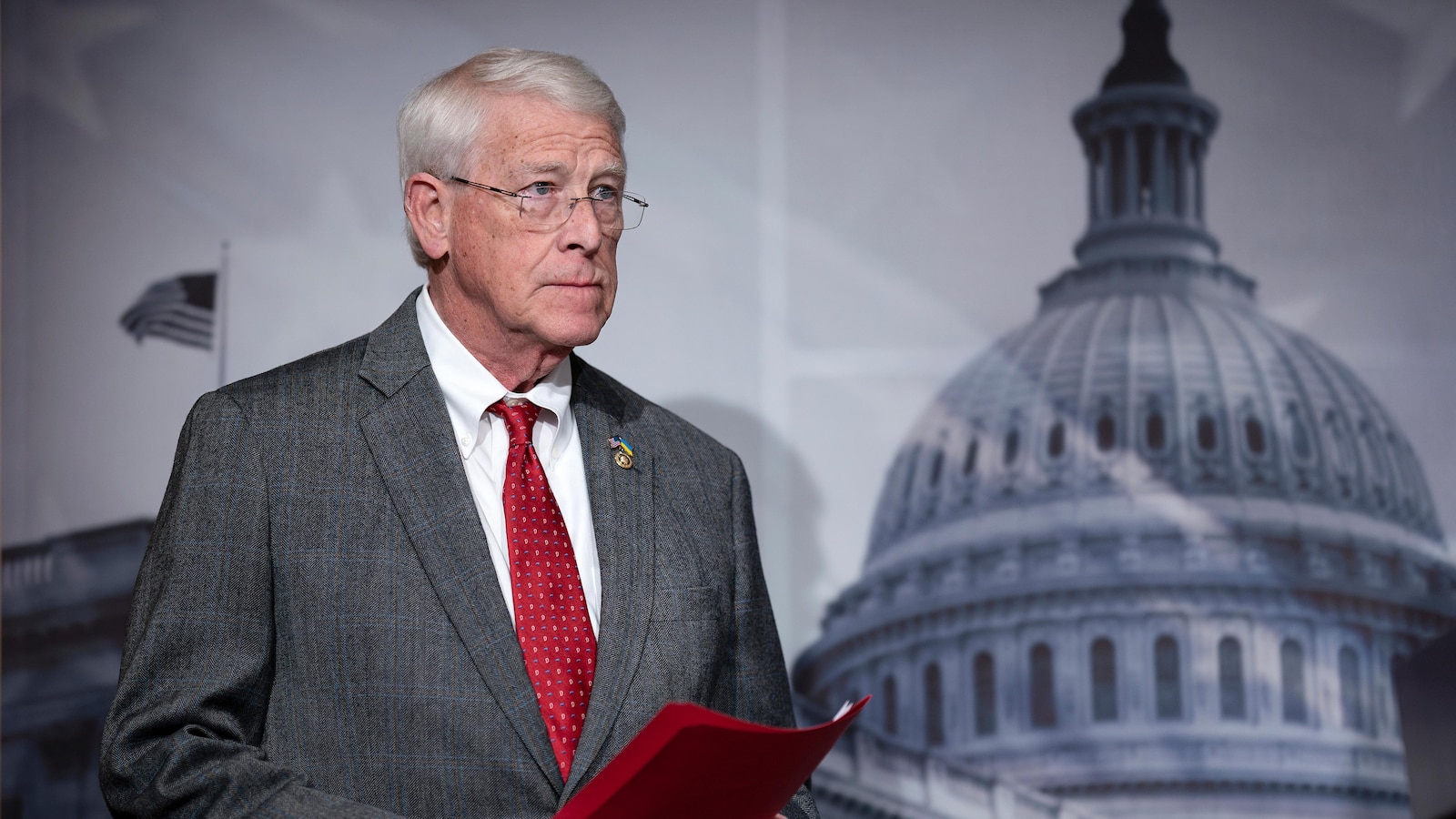
WASHINGTON — The top-ranking Republican on a Senate committee that oversees the military is calling for a “generational investment” in America’s defense, saying aggressive and significant spending increases are necessary to deter coordinated threats from U.S. adversaries like Russia, Iran and China.
Sen. Roger Wicker, a Mississippi Republican on the Senate Armed Services Committee, told The Associated Press that he will seek an additional $55 billion in defense spending over the limits that were forged in the deal to suspend the nation’s debt limit a year ago. Wicker explained his position in global terms, saying there has “never been such a level of cooperation and coordination among an axis of aggressors” that aims to challenge U.S. dominance.
The plan lays down a significant marker for Senate Republicans as they enter into a new round of budget fights with Democrats in the heat of a closely fought election year. The White House has proposed $850 billion in defense spending, adhering to the debt limit deal by proposing a 1% increase from the previous year. That plan is unlikely to keep pace with inflation and would seek to reduce the military’s costs by retiring older ships and aircraft.
Wicker acknowledged it would be “a hill to climb” to convince Congress to break from the spending caps at a time of deep political upheaval. Washington is still grappling with divisions over support for Ukraine, the aftershocks of two long wars in Iraq and Afghanistan and a presidential election between two presumptive candidates — Biden and Republican Donald Trump — who espouse vastly different visions of America’s role abroad.
But Wicker said the nation has no choice. “We would be very foolish on a national survival basis to adhere to that when it comes to national defense,” he said.
While GOP defense hawks have long advocated for robust defense spending, Wicker’s plan goes a step further, calling for a broad shift in the U.S. defense posture that would amount to a reshuffling of national priorities. Under his proposal, the military would eventually consume 5% of America’s gross domestic product — or total economic output.
Defense spending when measured as a portion of GDP is currently about 3% and has been declining since the height of the wars in Afghanistan and Iraq. It has not reached above 5% since the early 1990s.
Back in the 1980s and early 1990s, Wicker said, “nobody took a chance against the United States because we were powerful enough to keep the peace. We are simply not anywhere near that right now.”
“I think that the fact that we’re in a new Cold War is self-evident,” he said.
Wicker’s full plan is laid out in a paper he has been working on for the last year. In it, he makes the case for crafting a new generation of weaponry, pointing to Russia’s moves to expand its territory in Europe and China’s attempts to show increasing dominance in parts of the Pacific.
Closer ties between China and Russia were underscored earlier this month by a visit between leaders Vladimir Putin and Xi Jinping. The two-day visit — Putin’s first trip abroad after being inaugurated to a fifth term in office — reflected a growing partnership between the two nations, an alliance grounded in support for authoritarian regimes and dominance in their respective regions.
China has given diplomatic support to Moscow after its invasion of Ukraine and emerged as a top export market for Russian oil and gas, helping fill the Kremlin’s war coffers for the ongoing offensive.
Wicker said the high-level meeting between Putin and Xi “ought to be a wake up call.”
He said in his proposal that the U.S. faces “the most dangerous threat environment since World War II” and urges a national war footing appropriate for a long, drawn-out conflict with a major world power. For Wicker, that encompasses everything from addressing deferred maintenance on U.S. military facilities that don’t have the right voltage on power outlets to preparing for nuclear weaponry in space.
Still, the spending increases are likely to be viewed skeptically by lawmakers wary of growing the defense budget, which already dominates annual discretionary funding. The legislation to suspend the nation’s debt limit passed Congress with strong bipartisan support and aimed to limit federal budget growth to 1% for the next six years, although the spending caps were only mandatory through this year’s budget.
The House Armed Services Committee earlier this month approved with near-unanimous support an $884 billion proposal for the annual defense authorization bill, keeping within the spending caps but shifting funding towards specific military programs. Yet Senate Democrats are likely to resist further spending cuts to other government programs.
The Senate Armed Services Committee is set to craft the annual military authorization bill next month, but the chairman, Democratic Sen. Jack Reed of Rhode Island, has not publicly released the spending amount that he will propose. Wicker said that he had been in contact with Reed, as well as top Democratic appropriators, about the plan, but their level of support was not clear.
At the same time, defense hawks like Wicker are navigating the shifting politics of defense spending in their own party under Trump’s “America First” brand of foreign policy. Earlier this year, a $95 billion package of foreign aid for Ukraine, Israel and Taiwan faced heavy resistance from a large portion of congressional Republicans, even though much of the funds would be spent buying equipment and ammunition from U.S.-based defense manufacturers.
Senate Republican Leader Mitch McConnell, however, has been vocal about countering those within his party who want to push the U.S. towards a more isolationist stance. And Wicker said there was “an opportunity” to win broad support for redoubling U.S. efforts in the Pacific because congressional Republicans are still supportive of countering China.
As he works to convince Congress to rethink defense spending, Wicker said he was modeling his effort on the push that former Sen. John McCain, an Arizona Republican, made in 2017 as he tried to dramatically increase defense spending. That effort was mostly unsuccessful.
But Wicker expressed confidence that this time can be different.
With China’s military strength dramatically growing and Russia launching the largest land invasion in Europe since World War II, the difference between 2017 and now is “the reality on the ground,” he said.
In a bold move that has sparked both praise and criticism, a key Republican lawmaker has proposed a significant increase in defense spending over multiple generations. Representative John Smith, a staunch advocate for a strong national defense, unveiled his ambitious plan during a recent press conference, outlining his vision for bolstering the country’s military capabilities for years to come.
Under Smith’s proposal, defense spending would see a substantial increase over the next several decades, with a focus on modernizing and expanding the military’s arsenal to meet the evolving threats facing the United States. The plan calls for investments in cutting-edge technology, advanced weaponry, and strategic infrastructure to ensure that the country remains at the forefront of global security.
Smith argues that the increase in defense spending is necessary to address the growing challenges posed by rival nations and non-state actors, as well as emerging threats in cyberspace and outer space. He points to recent geopolitical developments, such as the rise of China as a global superpower and the proliferation of cyberattacks, as evidence of the need for a more robust and agile military.
Critics of Smith’s proposal have raised concerns about the potential impact on the federal budget and the allocation of resources to other critical areas, such as healthcare, education, and infrastructure. They argue that a significant increase in defense spending could lead to cuts in social programs and exacerbate income inequality, further widening the gap between the haves and have-nots in society.
Supporters of the plan, however, contend that national security should be the government’s top priority, and that a strong military is essential for safeguarding the country’s interests at home and abroad. They point to the role of the military in deterring aggression, maintaining stability, and protecting American lives and freedoms as reasons to support increased defense spending.
As the debate over Smith’s proposal continues to unfold, it is clear that the issue of defense spending will remain a contentious and divisive topic in Washington. Ultimately, the decision on whether to increase military funding over multiple generations will require careful consideration of the trade-offs involved and a thoughtful assessment of the country’s long-term security needs. Only time will tell whether Smith’s vision for a stronger military will become a reality or remain a contentious point of debate in the halls of Congress.


